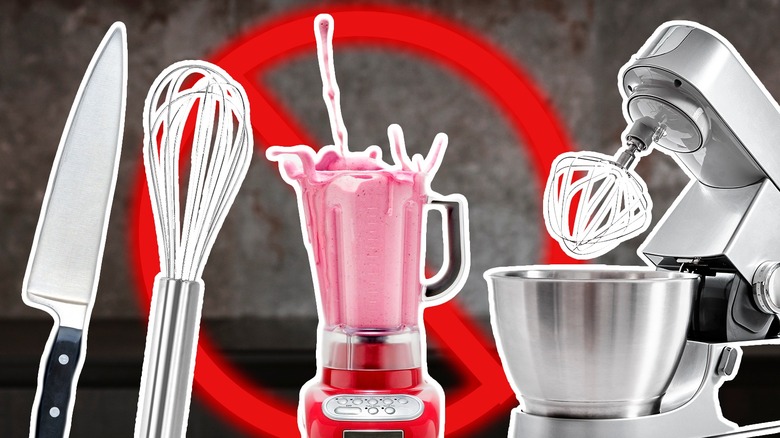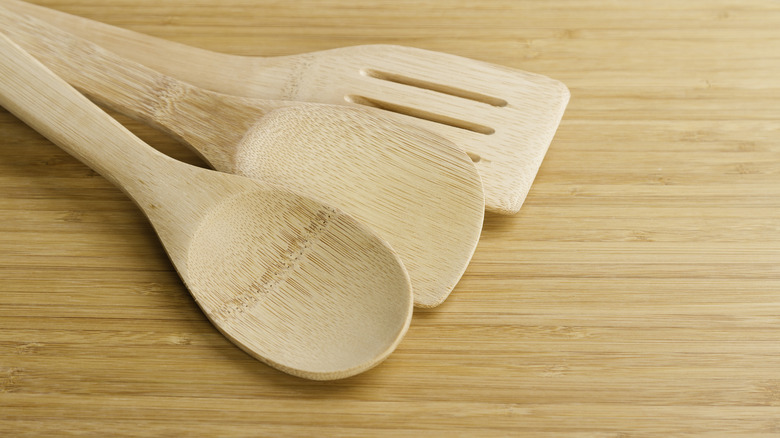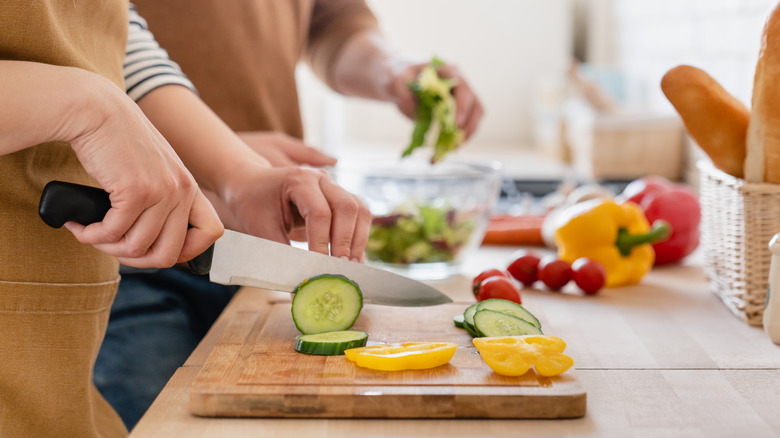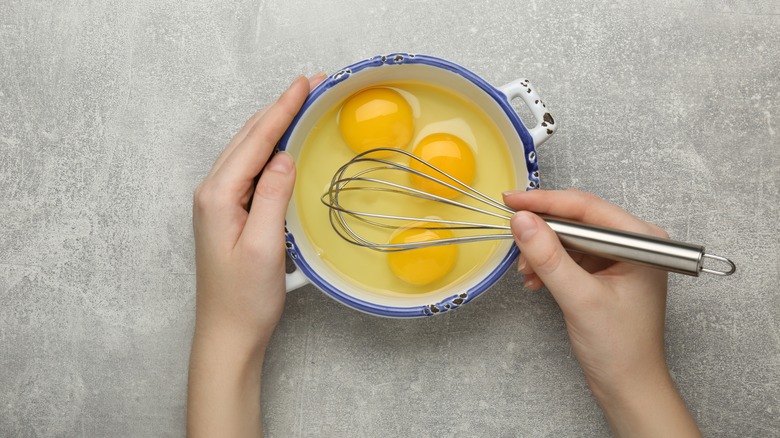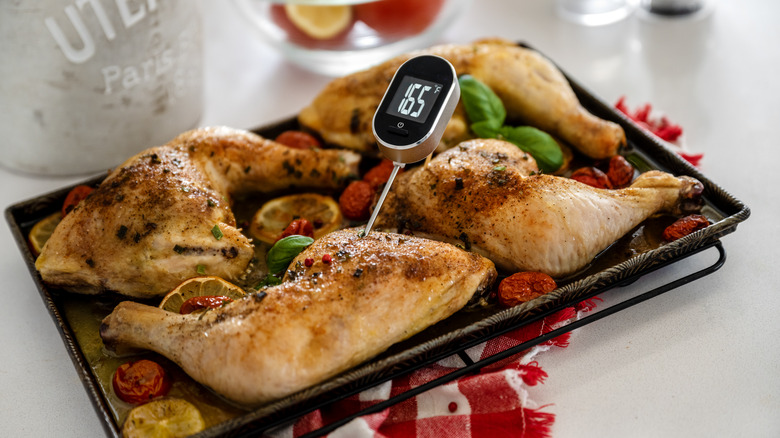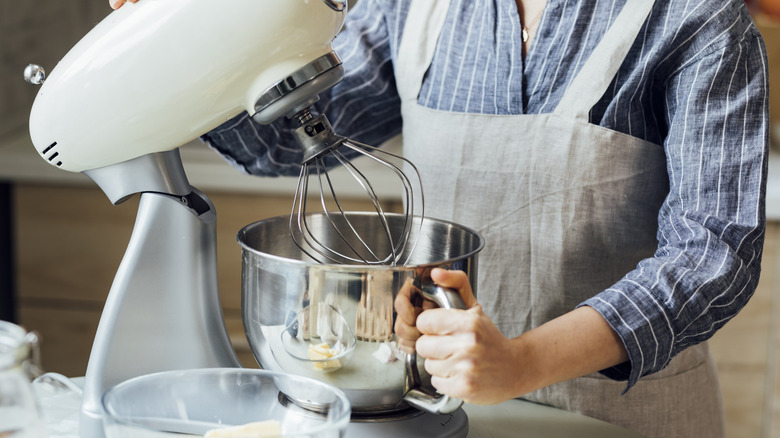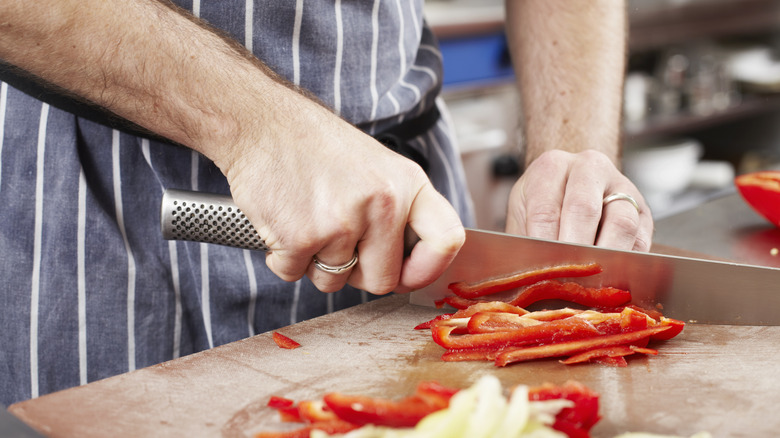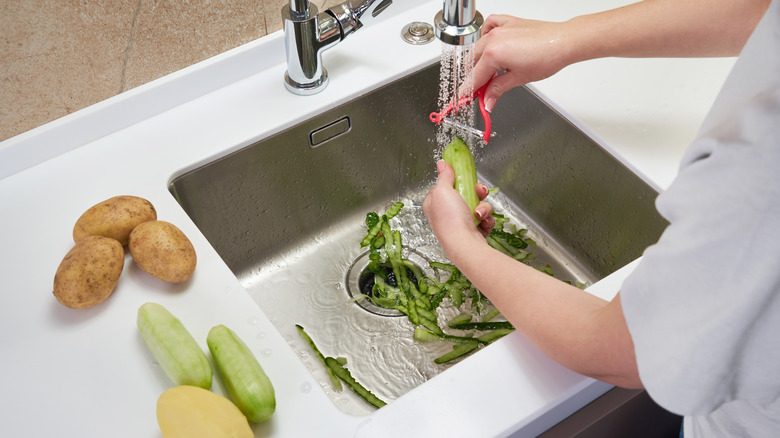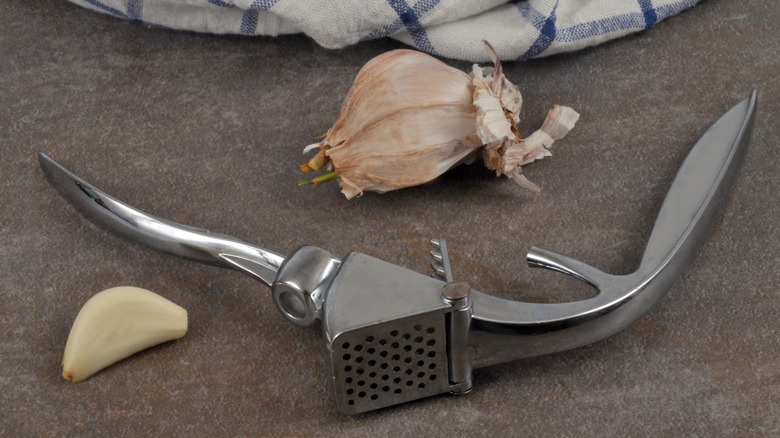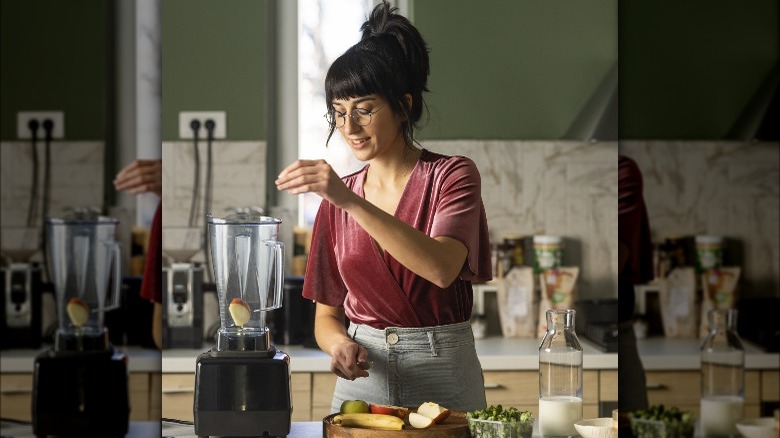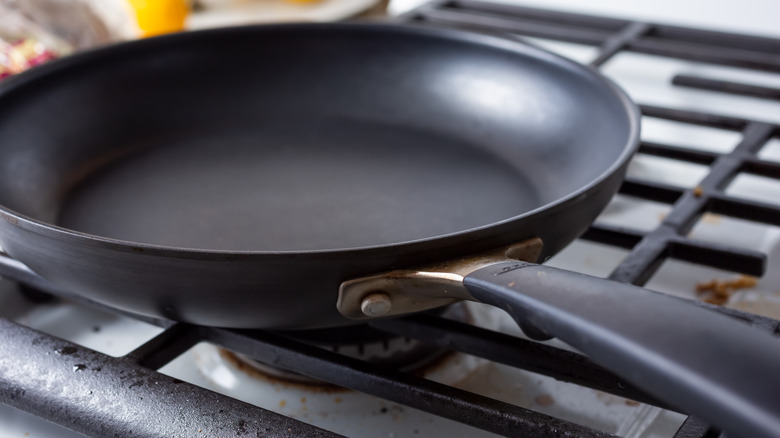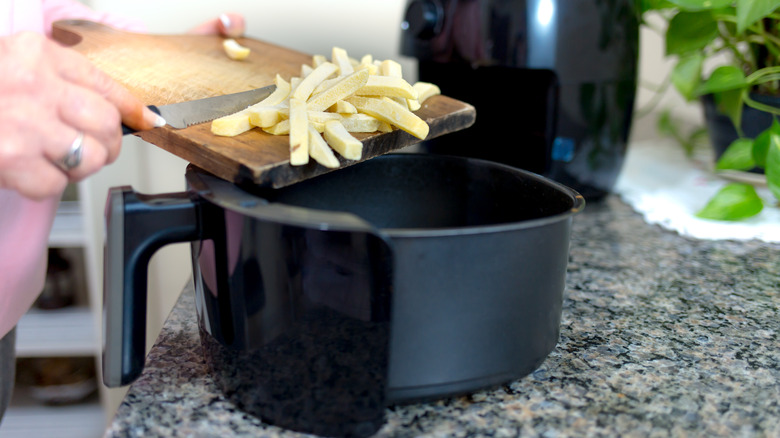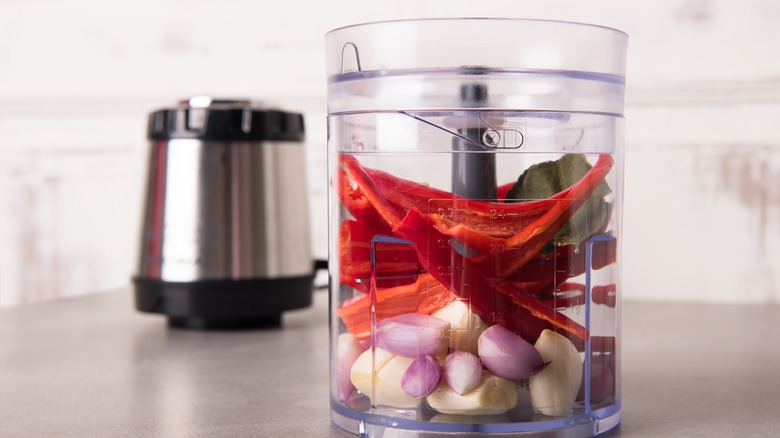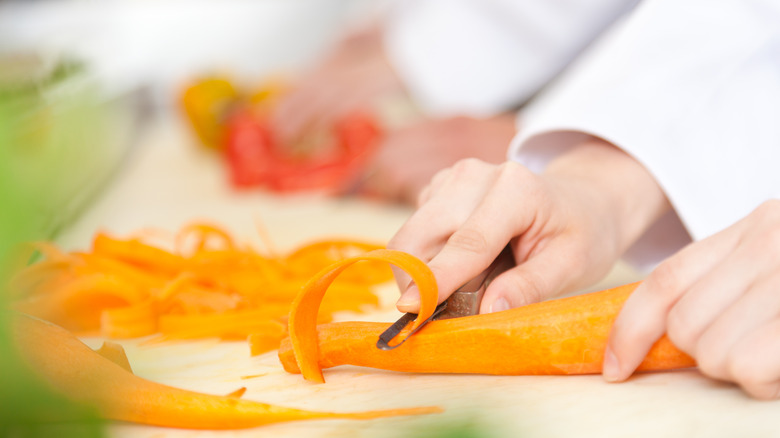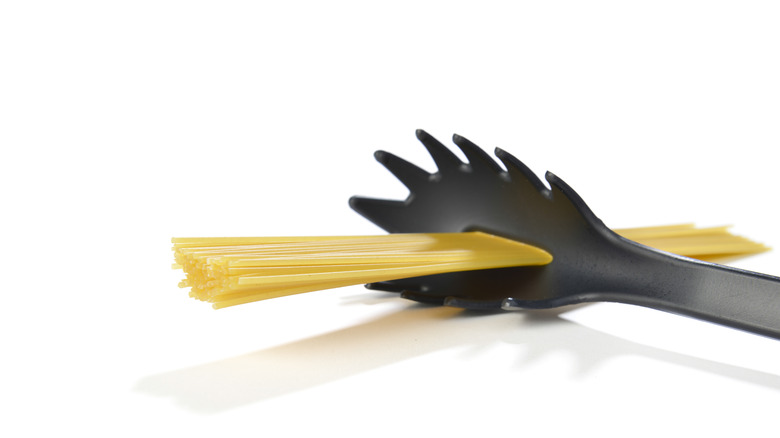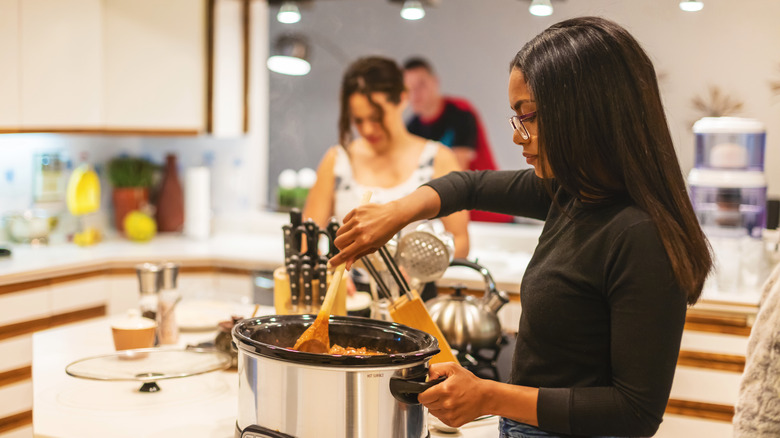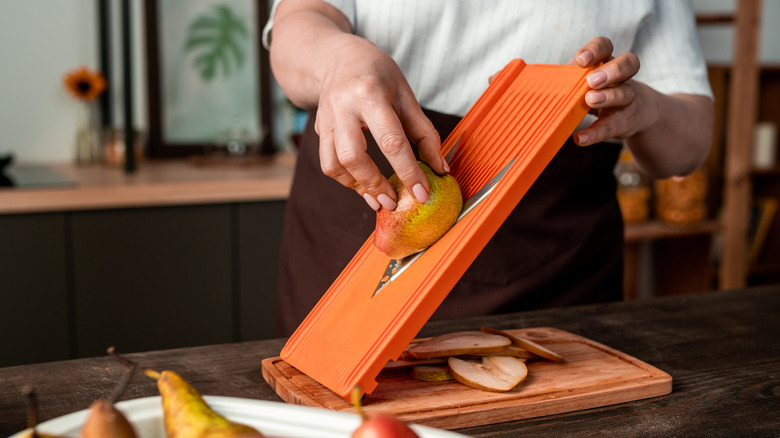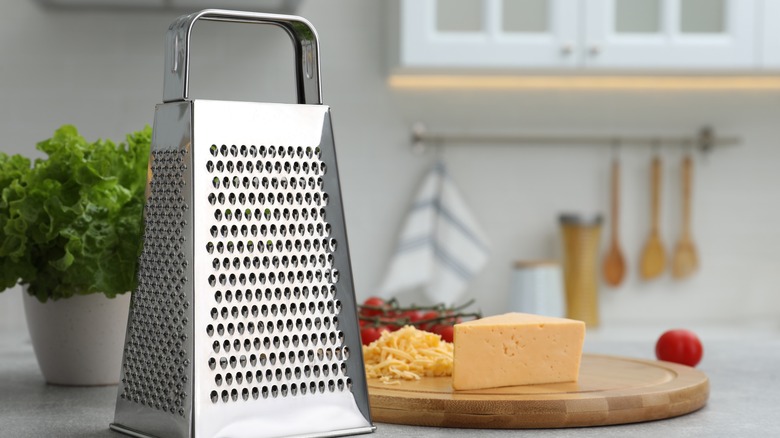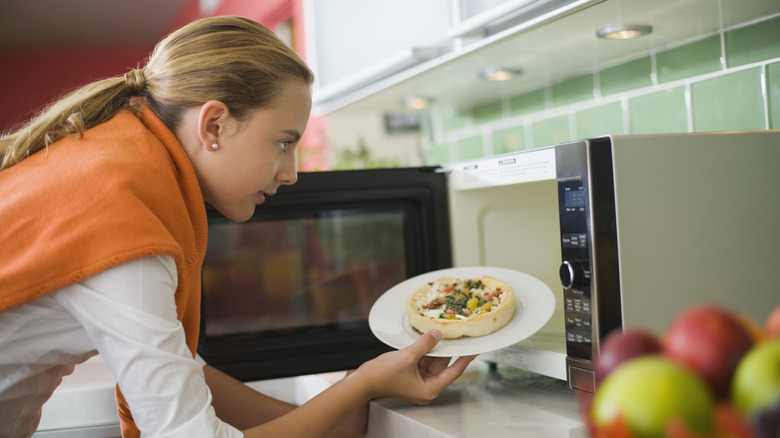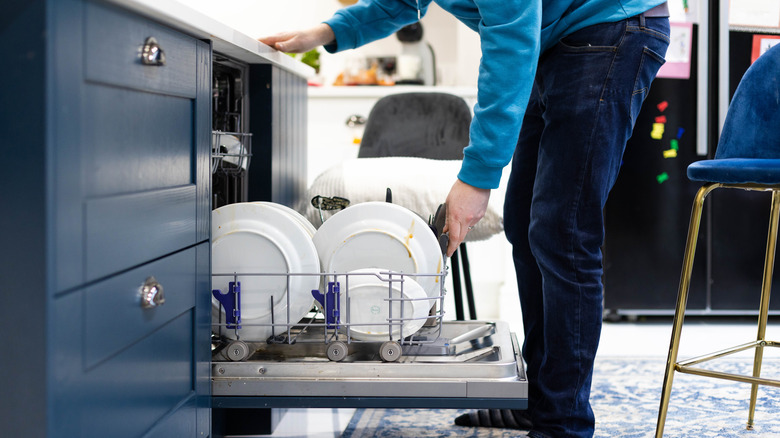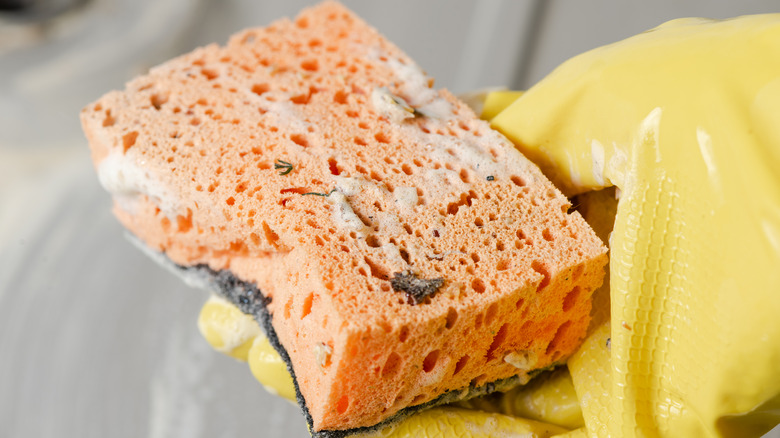20 Tools In Your Kitchen You've Probably Been Misusing
The variety of kitchen appliances, cookware, and cooking tools has expanded significantly compared to what was available 20, 50, or even 100 years ago. If you have a well-stocked kitchen, you likely have drawers and cabinets full of everything from cutting boards, garlic presses, stand mixers, meat thermometers, air fryers, and everything in between. While all of these tools can greatly simply meal prep, did you know that you might have been using them wrong this whole time?
There are several mistakes people make with everyday cooking tools such as whisks and veggie peelers. The same goes for those made with more specialty items, like air fryers, cheese graters, and mandolines. These mistakes can negatively impact how efficient you are in the kitchen, increase your risk of getting injured while cooking, decrease the lifespan of your various tools or appliances, and more. Have you been using some of the tools in your kitchen wrong?
Wooden cooking utensils
Wooden or bamboo spoons, spatulas, and turners are a staple in most kitchens. They're attractive, safe to use on nonstick cookware, and more eco-friendly than their plastic counterparts. However, if you're like many, you've been compromising the effectiveness and longevity of your wooden and bamboo cooking tools by not washing them correctly. Unlike many of your other cookware and tools, bamboo and wood utensils should not be put in the dishwasher. The higher temperatures in a dishwasher can compromise the wood and cause it to crack or splinter. Moreover, there is just too much moisture in a dishwasher that could warp the wood. Similarly, never leave your bamboo or wooden utensils soaking in water. Always hand wash these items and then dry them off with a dish towel immediately.
Cutting boards
If you've been using your cutting boards incorrectly, you may not even realize it. There are actually several mistakes many people make related to their cutting boards. The first is using one cutting board for all of their cutting tasks. You should not use the same cutting board for raw meat that you also use for chopping vegetables or slicing bread. Cutting boards can hold salmonella, E. coli, and other bacteria from the raw meat and transfer it to your other foods, according to Healthline. Similarly, if anyone in your home has a food allergy, always use a separate cutting board for any items they are allergic to. Otherwise, you're risking cross-contamination, which could trigger allergy symptoms.
Just as wooden cooking utensils should not be put in the dishwasher, the same is true for cleaning wooden cutting boards. Washing them in a dishwasher could cause them to warp, crack, or splinter, so they should always be hand-washed. One final way many people use their cutting boards incorrectly is by not choosing an appropriately-sized cutting board for the task at hand. Always choose a cutting board that is large enough to give you sufficient space to work and keep your food — and any juices from it — from falling off onto your kitchen counters.
Whisk
A whisk is such a basic cooking tool. Surely, you can't be using it wrong, correct? Sadly, you may be making some whisking mistakes that you'll want to remedy the next time you're whipping up a batch of pancakes or adding air to your eggs before making an omelet. The most effective way to use a whisk is to move it side-to-side through the ingredients. Compared to beating or stirring — motions many people use when whisking — side-to-side movements will be the best option to incorporate ingredients and keep them combined for longer, such as in the case of an oil and vinegar dressing. The reason that this motion is more effective than the more circular beating or stirring motions is that it is easier to sustain a quicker pace when working with the whisk. This means that you'll be able to deliver more force with each stroke, which will cause the ingredients to combine together better while also adding more air into the mixture, which is often the goal when whisking.
Meat thermometer
Meat thermometers can help you identify when chicken, pork, beef, fish, and other types of meat have reached a safe internal temperature and are ready to remove from the oven, grill, or stovetop. However, if you don't use them correctly, then they won't provide accurate information. Your meat may be dry and overdone or undercooked and potentially unsafe to eat. The right way to use a meat thermometer is to insert it into the thickest part of the meat. The thicker portions of meat will cook more slowly than the thinner ends, so inserting the thermometer in this region will provide you with the lowest temperature of the piece of meat you're cooking. Once this part has reached a safe internal temperature, the piece of meat or fish can safely be removed from the oven, grill, or stovetop. Inserting the thermometer into a thinner portion can provide a false read for the overall piece of meat, and you could make yourself or others sick by eating it.
Stand mixer
Believe it or not, you may have been using your stand mixer wrong all of these years. One way that you could have been misusing your stand mixer is by starting it at too fast of a speed. Even if you want to beat the ingredients in the bowl, you need to start off at a slower pace. When you start it at full speed, it can cause the ingredients in the bowl to splatter. Beyond making a mess on your countertops, walls, or even your shirt, this can also negatively impact the ratio of ingredients in the bowl and cause your recipe not to turn out properly. Many people also don't realize that you often need to adjust the height of the attachment head. If it is too high that it is barely reaching the ingredients in your mixing bowl, they're not going to get incorporated properly. Conversely, if it is touching the bottom of the bowl, it is too low. If the attachment rubs against the base of the bowl, it will create friction. This will cause unneeded strain on the mixer's motor, which could decrease its lifespan. The rubbing motion can also damage the mixing bowl. To adjust the height of the attachment, unlock the mixer head and unplug it from the wall. There is an adjustment screw under the head that will let you raise or lower the height of the head, turning it counterclockwise will raise the head and turning it clockwise will lower it.
Knives
Many people don't know how to properly hold a knife. An improper holding technique is not only potentially unsafe, but it is also not going to let you cut food as quickly or effectively. The best way to hold a knife is to use a pinch grip. For this technique, you should wrap your pinkie, ring finger, and middle finger and the handle of the knife right where it meets the blade. Then, use your thumb and pointer finger to pinch the sides of the blade. It may take you some time to get used to this holding technique, but with some practice, you'll find that you're able to slice and chop more efficiently without risking cutting your fingers. Compare this to holding the knife just by the handle — as many people tend to do — which leaves the knife unbalanced and more difficult to control.
Garbage disposal
Yep, you may have also been misusing your garbage disposal. You likely already know that you need to leave the water running when using your garbage disposal to help push the food down through the pipes and prevent it from clogging. However, did you know that the water temperature you choose is also important? If you use hot water, fats from the foods in the disposal may congeal and stick to the blades. When this happens, the motor will be forced to work harder to keep the blades spinning, which can cut back on its usable lifespan and force you to purchase a new one sooner than would have otherwise been necessary.
Garlic press
When you want to add fresh garlic to a recipe, you likely reach for your garlic press. However, if you've been adding the extra step of peeling each garlic clove before pressing it, you've been making more work for yourself. With most garlic presses, peeling the clove is unnecessary. If you put an unpeeled clove in the hopper in the garlic press, it will push the garlic through the skin and out through the holes in the press. After pressing the garlic, you'll just need to remove the skin from the hopper — which can be done using the cleaning tool that likely came with the press.
Blender
Did you know that you may have been adding ingredients to your blender in the wrong order? If your smoothies have lots of chunks or you have to shake them up and blend them a second time, then it's even more likely that you've been making this blending mistake. The reason your ingredients aren't getting blended together properly is that you haven't been adding them in the right order. You should always add the liquid ingredients first. This way, the blades won't get caught up on chunks of larger ingredients and will be able to create a vortex to powder through all of the other components in the blender. Anything frozen or hard, like nuts, should go in last so that it is on the top of the blender. Of course, if you're using a personal smoothie blending cup that you're going to turn upside down before blending, you should reverse the order of ingredients and add the frozen items first and the liquids last.
Nonstick cookware
There are several ways people misuse their nonstick cookware. One of these ways is by using metal utensils in the pots and pans. Metal utensils can scratch the finish on these cookware pieces. This can cause the finish to flake off in the dishes you're preparing, making them less safe to use. Another mistake with nonstick cookware is setting the burner to high heat. If the heat is set too high, it may release toxins from some types of nonstick coating. When you need a really hot pan, such as for searing meat, pull out your stainless steel cookware. Similarly, you also don't want to overload the basket or trays when cooking foods in the air fryer. There needs to be space around the items you're cooking for air to flow. Otherwise, the food items won't cook evenly. Don't forget to also rotate food items and trays during the cooking process. This will also help ensure more even cooking.
Air fryer
If you have an air fryer, then you already know how much it can simplify your time in the kitchen. But are you making some of the common mistakes with an air fryer that could be preventing you from getting the most out of this small kitchen appliance? One mistake many people make is not leaving enough space around their air fryers. If it is right on top of your backsplash, cabinets, or other cooking tools, it may overheat due to a lack of air circulation. Similarly, you also need to leave enough space between the food items you're cooking in the air fryer. If there isn't enough space for air to circulate, they won't end up cooking evenly. This means that you cannot overstuff your basket or trays; you may just need to cook a few different batches. Another important step to ensure even cooking that many people skip is to rotate the trays of food items throughout the cooking process.
Food processor
Did you know that a food processor is not the same as a blender? If you've been using the two small appliances interchangeably, then you've been making a big mistake. While blenders are good for liquid ingredients and recipes like smoothies and milkshakes, food processors are often the best choice if you want to chop ingredients for a recipe. They often come with an assortment of blades for puréeing, chopping, and mixing goods together. These blades rotate more slowly than those of a blender, which is why they are better suited for chunkier recipes. So, if you've been reaching for your food processor to make smoothies, switch to the blender. Save using the food processor for making things like croutons, shredding, slicing, or chopping vegetables, making tapenades, pesto, or salsa, or ricing broccoli, cauliflower, or other vegetables.
Vegetable peeler
Many people don't realize that vegetable peelers have two blades, not just one. This means that if you've only been peeling in one direction, you've been making things more difficult for yourself. The design of a vegetable peeler actually allows users to peel both towards and away from themselves, which can reduce how long it takes you to peel fruits and vegetables. Engaging in one-way peeling isn't the only mistake you may have been making when using a vegetable peeler. Many people assume that since they are removing the peels from the fruit or vegetable, that washing them first isn't necessary. However, dirt and bacteria from the skin of the produce item can get on your fingers or the peeler blades and transfer back to the peeled and clean part of the food. Always wash before you start peeling.
Spaghetti spoon
Bet you're wondering how you could possibly use a spaghetti spoon the wrong way. If you're only thinking about using the spoon for serving the cooked pasta, then there is your error in thinking. Believe it or not, many spaghetti spoons are also designed to help you measure out an appropriate serving of spaghetti noodles. Take a look at your spaghetti spoon. If it has one larger hole in the center, then you can use it to measure one serving of spaghetti. The number of uncooked spaghetti noodles that will fit in the hole should equal the recommended serving size. Try it yourself and see how it works.
Slow cooker
A slow cooker is another small kitchen appliance that everyone assumes they know how to use properly. Unfortunately, this isn't the case, and you may have been using yours wrong for all of these years. One way you may have been misusing the cooking tool is by opening the lid as your food is cooking. It is tempting to open the lid and check on what you're cooking, but doing so will let steam escape and slow down the cooking process. You may not realize that the order you add ingredients to the slow cooker matters. Meat should be placed closer to the bottom and the heat source, while leafy vegetables and other finer ingredients should stay at the top, slightly further from the heating element.
Mandoline
If you've been using your mandoline incorrectly, as many people do, you could be putting your safety at risk. Mandolines are sharp. Most come with a finger guard that should always be used to prevent you from inadvertently slicing your fingers. If your food doesn't fit within the guard, cut it down to make sure you can keep yourself safe when slicing. If your mandoline didn't come with a finger guard or you lost it, purchase a pair of heavy-duty kitchen gloves to wear as you slice. When working with a mandoline, always use your dominant hand to slice the food and hold the device steady using your other hand.
Cheese grater
Do you have a metal box-style cheese grater in your kitchen? Are you confident that you've been using it correctly? As it turns out, this is yet another tool that is often misused in the kitchen. Cheese graters have lots of holes in a variety of sizes. The type of cheese you're grating should tell you which size holes to use. The larger, spikier holes are better for grating softer cheeses, like cheddar, into more coarse shreds. The smaller holes will be best for grating parmesan and other hard cheeses into finer shreds. Follow this advice to make sure that your cheese is properly grated for your next recipe.
Microwave
The microwave is another item in your kitchen that you might not be using correctly. There are actually several different mistakes people make with their microwaves, which can impact everything from safety to the mess you'll be left to clean up. You probably already know that putting metal pans or utensils in the microwave is a big no-no due to the risk of an explosion or fire, as explained on Wonderopolis. But did you also know that there are certain food items that have the potential to explode and possibly ignite in the microwave? Hot dogs, whole potatoes, hot peppers, and other items should be punctured before cooking to ensure steam can escape as they cook, according to CNET. Another microwave mistake is using the quick start buttons. When you manually enter the cooking time, you can also adjust the power setting. Many foods will heat up more evenly if you use a reduced power setting.
Dishwasher
We're betting you're surprised to see a dishwasher on this list. Before you jump to any conclusions and assume that you couldn't possibly be making any mistakes with your dishwasher, keep reading. If you have only a few dishes that need to be cleaned, do you opt to hand wash them instead of running the dishwasher with the goal of saving water? Well, unfortunately, you're likely wasting more water by washing your dishes by hand. Energy Star-certified dishwashers use under 4 gallons of water, which is likely a lot less than you'll use washing dishes at the sink. Similarly, pre-rinsing your dishes before putting them in the dishwasher is also going to wastewater. Having some dishes that are more thoroughly pre-rinsed than others can throw off the sensors in a dishwasher and make it think all of the items are cleaner than they actually are. At the end of the cycle, some of your items may not be fully cleaned.
Sponge
While a sponge is not used for cooking, every kitchen has one that is used for cleaning kitchen tools and cookware. Did you know that a kitchen sponge is often the dirtiest item in the house — even dirtier than a toilet seat? Sponges can harbor bacteria, such as salmonella and E. coli, according to The Healthy. If you haven't been regularly cleaning your sponge in the dishwasher or microwaving it for two minutes every day, then you'll want to change your routine immediately. In addition to frequent cleaning, you should also regularly replace your sponge or just do away with it altogether and use dish rags or kitchen brushes that are easier to clean.
